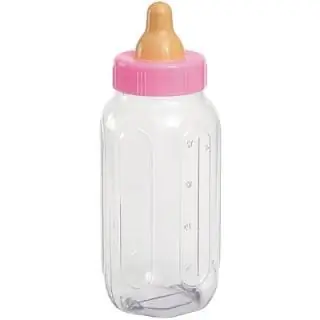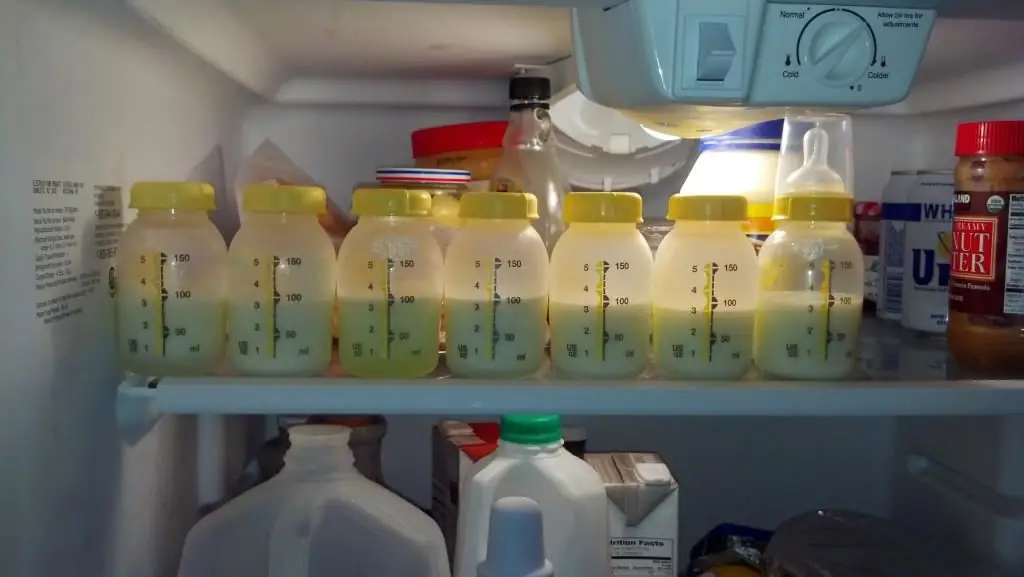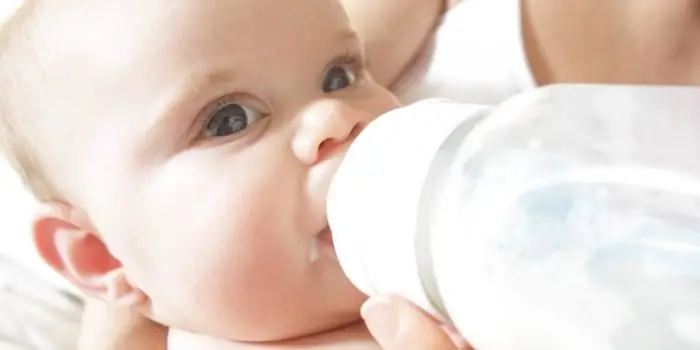2025 Author: Priscilla Miln | [email protected]. Last modified: 2025-01-22 17:55:21
Baby bottles for feeding - the first dishes of a small person. They come in a variety of designs, capacities and materials.

Baby bottles can be silicone, glass or plastic.
Most often for the manufacture of glass containers, its refractory types are used. They are not afraid of exposure to high temperatures, but they can break from a strong blow. Glass baby bottles are easier to keep clean and last longer than plastic or silicone bottles. The only downside is the considerable weight.
Plastic baby bottles are made from highly durable and safe polycarbonate plastic. They are quite light and practical to use. In addition, they withstand high temperatures up to 120 degrees.
Silicone baby bottles are made from high quality silicone. They are impact and boil resistant, but tend to stain.
Baby bottles are anti-colic in shape,figured, with a wide neck and standard. Each of these species has its own characteristics.

Anti-colic bottles are made of plastic, which has a peculiar curved shape. During feeding, the baby does not swallow the air accumulated in the bottle, so the likelihood of colic is minimized.
Figured bottles are also made of plastic and have a wide variety of shapes - from round to oblong. The hole in the middle makes it easy for baby to hold it in small hands.
Wide neck bottles are made from both silicone and plastic. It is more convenient to pour porridge or mixture into them, as well as wash them. They are more stable and less likely to tip over.
Classic or standard shaped bottles are made from plastic and glass. They most often have an elongated narrow shape.
Feeding bottles can have different capacities - from 80 to 330 ml. Thanks to the scale located on the side, the amount of cooked food for the baby is easier to dose, and it is also easier to determine the amount of porridge or mixture eaten by the child. For a newborn, it is preferable to choose a bottle with a capacity of 125 ml, and for a six-month-old baby, a more capacious one (about 260 ml) will do.
Today, you can find more modern analogues that are equipped with a temperature indicator for the finished mixture. They are quite convenient and practical to use, especially for new parents.
How to sterilize baby bottles?

First of all, remember that they must be washed immediately after use. The first step is to unscrew the lid and remove the nipple. Rinse the components of the bottle under running water using a brush specially designed for this purpose. Place a clean nipple, cap and bottle in a deep saucepan and cover with water (it is necessary to achieve complete immersion). Boil the bottles for at least five to seven minutes. Then place them on a clean towel and cover with gauze.
It is important to remember that baby feeding supplies must be stored and kept in perfect cleanliness. If you find the slightest defects in the form of chips or cracks, you must replace the bottle with a new one.
Recommended:
How long does the finished formula keep in the refrigerator? How to store formula in feeding bottles

Mother's milk is a unique food product, the composition of which contains about 500 useful substances necessary for the full development of the child. What to do when breastfeeding is not possible? How to maintain the he alth of the child and provide him with a fortified diet? Special store formulations will help with this. You can learn more about breast milk replacer, how to prepare it and how long the finished formula is stored in the article
Riddles on traffic rules for children: learning the rules of the road in a playful way

Riddles on traffic rules - a simple and convenient way to explain to your child the basic rules of behavior on the road and protect yourself from getting into an accident
Norms and rules of the family. Family member rules

Usually, couples who get married have little idea of what awaits them as a result. This mainly concerns young people, who believe that after the registry office, they expect a period similar to dating time. In fact, everything is different, because living together and seeing each other several times a week are completely different concepts. In order for everything to be in the best way at home, it is very convenient to draw up family rules, which you will follow later
How to hold a baby: rules for caring for a baby, necessary knowledge and skills, tips

The birth of a child is a very touching and crucial moment. If this is the first child for newly-made parents, then even in the maternity hospital they will have many questions related to caring for the newborn. The vast majority of parents admit that they do not know how to hold the child in their arms until the baby gets stronger, that is, in the first 2-3 months. But by learning a few simple rules and recommendations for caring for a newborn, you can enjoy positive moments without fear
Baby food "Baby". "Baby" - baby food from birth

So you became a mother! But this joyful event can be overshadowed by the impossibility of breastfeeding. There are many different reasons that affect this natural physiological process, but whatever they are, you have to think about how to feed the baby. And in this case, infant milk formulas come to the rescue. One of the most popular is baby food "Malyutka"

